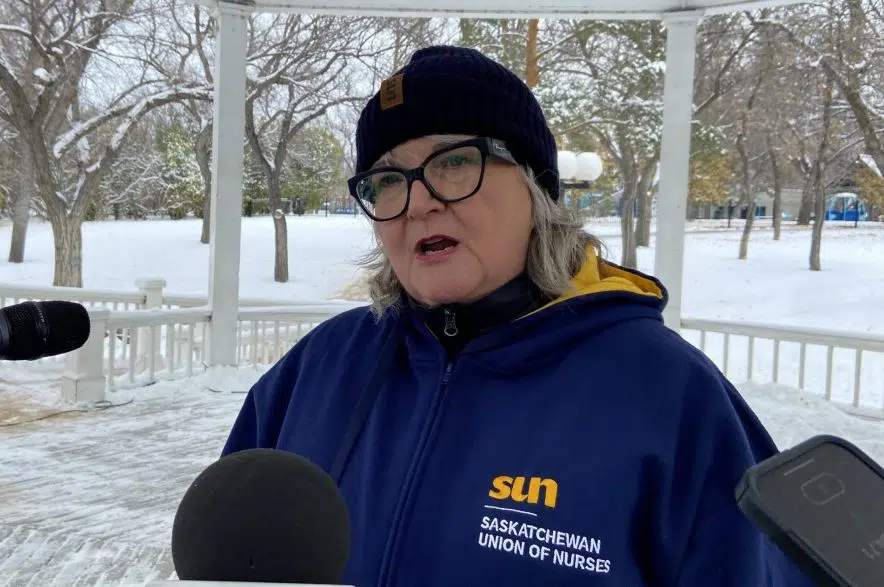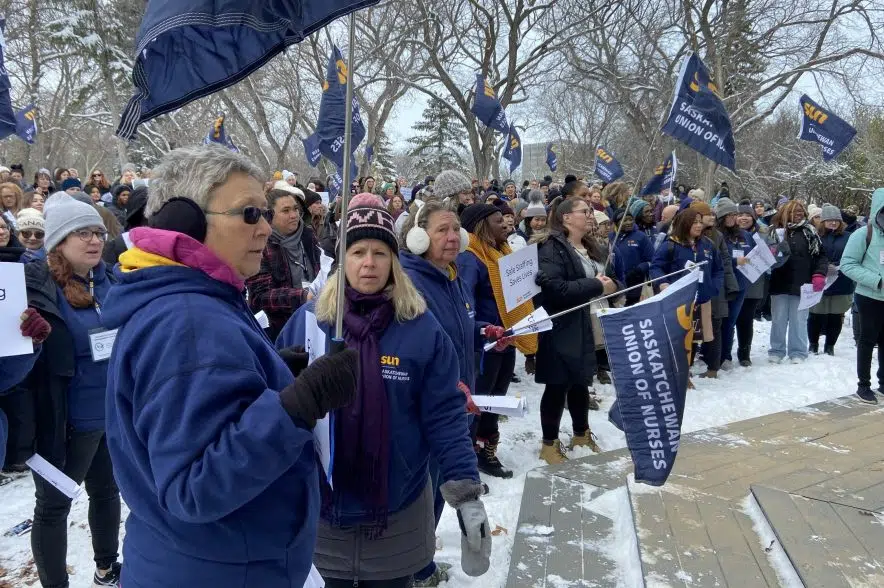Crying “Hey hey, ho ho, unsafe staffing’s got to go,” roughly 150 nurses rallied across from the Saskatchewan Legislative Building on Wednesday.
The rally comes on the heels of a survey released in October that heard from about 1,600 registered nurses in the province.
Four in five of the RNs (81.0 per cent) reported knowing of a time when patients were at risk due to short staffing. Of those who were aware of risk due to short staffing, more than half (51.4 per cent) reported the risk is frequent.
“We have very, very sick people being cared for in hallways and let’s unpack that a little bit,” Saskatchewan Union of Nurses president Tracy Zambory told reporters at the rally.
“When you are cared for in a hallway, that means there is no emergency bell to call. There’s no oxygen, there’s no blood pressure, there’s no nothing. There’s a bed and a hallway and a registered nurse who is running up and down the hallway with no safety equipment to try and keep these people alive.
“When you come to the emergency room, it’s not because you have the sniffles. You have come to the emergency department because you are in dire health crisis. It’s because there are no physicians to care for them, public and home care is just as short-staffed as everywhere else, so we have people coming into the emergency room who cannot get the care they require.”
In a news release Wednesday, SUN gave more details about the results of the survey.
More than nine in 10 nurses noted there have been times when short staffing has led to longer wait times (94.7 per cent) and delayed or missed assessment or treatment (90.7 per cent).
Similar proportions indicated experiencing times when short staffing led to poor patient experience (89.6 per cent), service reductions or disruptions (88.8 per cent), reduced standards of care (88.6 per cent), and delayed or cancelled procedures (85.3 per cent). Almost three-quarters said short staffing had led to unplanned or unnecessary admissions (73.2 per cent) and avoidable deterioration in patients (71.5 per cent).
“Long waits, missed treatments, cancelled procedures, avoidable hospital admissions; these and many other indicators of increased patient safety and risk are occurring across the system every day because of registered nursing shortages,” Zambory said. “Registered nurses need to see urgency and a clear political will to solve this crisis. We cannot wait to act when so many patients are needlessly suffering.”
According to the survey, three in five registered nurses (61.8 per cent) have considered leaving the profession in the last 12 months for another line of work, with nine in 10 (91.7 per cent) saying their working conditions have had a negative impact on their mental health.
More than half (56.4 per cent) deemed workplace mental health supports to be inadequate, while almost three-quarters (73.8 per cent) provided negative ratings for current government efforts to retain and recruit a registered nursing workforce.
“There’s an irrefutable link between registered nurse burnout and poorer patient outcomes, and right now, we risk worsening shortages as faith in workplace support and commitment to fix the problem dwindles,” Zambory noted.
SUN is critical of the use of private nursing agencies to fill the gap. The union said a Freedom of Information request it filed revealed that in the 2.5 years prior to June 30 of this year, the Saskatchewan Health Authority (SHA) has spent $78.5 million on contract nursing services, with expenditures exceeding $45 million in 2022 alone.
“The misplaced focus on private agencies is costly to taxpayers, averaging $120 per hour, and it is not sustainable,” Zambory said. “We should be talking directly with registered nurses on the ground to build homegrown solutions; something I’ve repeatedly spoken to the SHA, the Ministry of Health, and Premier Moe about.”
SUN has been advocating for a nursing task force that includes unions, regulatory bodies, educational institutions, the government and employers to jointly develop a Saskatchewan-made plan to address the crisis.
The survey was conducted by Regina-based Praxis Analytics on behalf of SUN and yielded a general margin of error of plus or minus 2.2 per cent at the 95 per cent confidence level.













